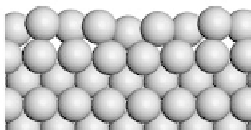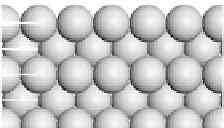Environmental Engineering Reference
In-Depth Information
microscopy (STM) [Binnig et al., 1984]. Several theoretical attempts to explain the
structure of the reconstructed surface can be found in the literature, ranging from
tight-binding approaches [Tomanek and Bennemann, 1985], to simple glue models
[Ercolessi et al., 1986], the application of embedded atom potentials [Dodson,
1987], and even first-principles calculations [Takeuchi et al., 1991].
Besides surface reconstructions induced by heat treatment, potential-induced
reconstruction has recently become a topic of interest in electrochemistry. It has
been observed that at potentials negative with respect to the potential of zero surface
charge, f
pzc
[Kolb, 1996, 2002; Dakkouri, 1997], the reconstructions found under
UHV conditions are also stable in contact with an electrolyte. Although all low
index faces of Au and Pt undergo potential-induced reconstruction, it has been particu-
larly well characterized for Au(100) (Fig. 5.5).
Analysis of STM images obtained for an Au(100) electrode in a 0.1M HClO
4
elec-
trolyte solution at different electrode potentials indicate that below approximately
20.25 V (with respect to a saturated calomel electrode, SCE), the reconstruction of
(1
1)
!
hex starts by forming various “hex”-reconstructed domains with different
surface orientations. At more negative electrode potentials (20.3 to 20.4 V) large
regions of (1
1) terraces are transformed into corrugated domains within a few min-
utes, and holding the potential at 20.35 V for about 10 minutes or longer results in a
surface predominantly containing hexagonal reconstructed domains. Since the first
surface layer is close-packed, the measured capacity curve was found to be comparable
to that obtained for Au(111).
When the electrode potential is altered to positive potentials (.
þ
0.55 V),
a progressive removal (“lifting”) of the reconstruction and a return of the dominant
(1
1) structure is noticed by showing a pronounced current peak in the cyclic
Figure 5.5 Top and side views of the unreconstructed Au(100)-(1
1) and the (5
1) hexago-
nal reconstructed Au(100)-hex surfaces. Unit cells are indicated by rectangles.






















Search WWH ::

Custom Search